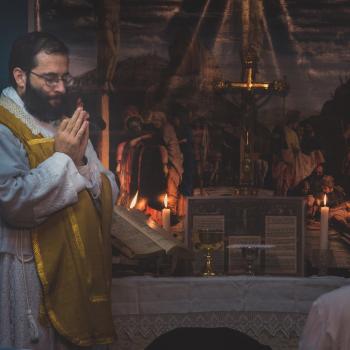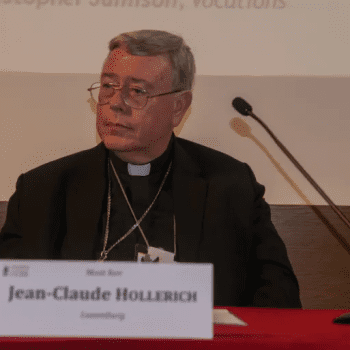
Ever since Amoris Laetitia came out, there has been confusion about how to interpret chapter 8. I have written extensively on this document and with the second half of my more academic take came out this week, I think it is time to put together everything I’ve written for a complete guide. This guide will be made of a dozen articles I’ve written on the topic. (Yikes! I didn’t realize it was that many.)
Here, I divide these article into four sections: general pieces on Amoris Laetitia (2), my take on Communion in Chapter VIII (4), other people’s takes on Communion (3), and modes of interpretation (3). There are others who have written well about this but many of them are easily linked from my articles.
On Amoris Laetitia in General
1. Amoris Laetitia Quotes
On the day the document was released, I collected the top quotes into an article. I began,
News reports focus on a few paragraphs of Francis’s new document, Amoris Laetitia, namely 242-243, 250, and 298-305, yet this is but a small part of the document. Instead, I want to give you a medium-length summary of the whole document using quotes and paraphrase.
Then, when reading the key passages, I explained:
This chapter deals with the Church’s outreach to the weak or those who have fallen in a particular way. It is the most controversial chapter with people interpreting it in ways that go beyond and even at times against the text. I will try to stick as close to the text as possible while still summarizing to avoid misunderstanding what Francis wants to say which follows directly from what John Paul II would say.
2. Study Guide
I also wrote a study guide on Amoris Laetitia for personal study or small groups. It is quite related to the article of quotes above so I won’t post more on it.
Chapter VIII on Communion for the Divorced and Remarried
3. Summary
After the document came out in April 2016, I kept waiting for someone to explain the right interpretation well when so many doubted it. In February 2017, I finally published my explanation on why it does not allow Communion without an intention to avoid relations.
Contrary to popular opinion, the text of Amoris Laetitia does not allow those flagrantly or intentionally having marital-like relations in a “second marriage” to receive absolution or Communion.
However, Francis emphasizes mercy for those who are either ignorant, or who intend to abstain from sexual relations but occasionally fail. Francis’s emphasis on mercy seems to come from a stronger emphasis on the wound of original sin in his anthropology.
4. Positive Argumentation
From when I published that piece, I began thinking of putting this in a more academic format complete with footnotes, AAS / DH numbers, etc. Homiletic and Pastoral Review agreed to publish it in two parts. The first half made the positive argumentation for a proper reading of Amoris Laetitia.
Francis clearly does not intend to make new rules. Near the beginning of the controversial chapter eight he declares, “Neither the Synod nor this document could be expected to provide a new set of general rules, canonical in nature and applicable in all cases.”
In the lines that follow, Francis discusses the need to accompany those in “second marriages” and similar situations, and discern how and when to show them the reality of their sin. However, the Pope clarifies what he means by discernment: “Discernment can never prescind from the Gospel demands as proposed by the Church.” Then he gives criteria for discernment that sound straight out of an Ignatian guide on the topic: “Humility, discretion and love for the Church and her teaching, in a sincere search for God’s will and a desire to make a more perfect response to it.” Thus, no matter what he says about discernment anywhere in the document, he has set up existing Church teaching as a fence around what can be discerned. Discernment is a process of deciding spiritually what to do — like deciding which prayers to say daily — but a basic pre-condition for proper discernment is that it cannot go outside Church teaching.
5. Responding to Objections
This week, H&PR published the second half, which takes up all the reasons people argue for allowing widespread Communion without repentance as objections.
Objection One: No Longer Mortal Sin? […] The Church has always taught that a mortal sin, depriving the person of sanctifying grace, requires grave matter, knowledge of the sin, and sufficient freedom. Many people in irregular situations either do not realize the irregularity or have some restriction on their freedom.
Objection Two: Follow Your Conscience. […] If a person willfully deforms their conscience, they can be at peace while committing repeated adultery but this peace is false. Part of the Church’s duty is to inform consciences and if someone is willfully deforming their conscience to accept sin in their life, and thus having a culpably erroneous conscience, the Church cannot support that by offering sacramental absolution and Communion. In fact, the restriction from the sacraments should be part of the Church’s effort to call such people out of their erroneous conscience.
Objection Three: Footnote 351. […] Setting one’s will on performing an act that is a mortal sin, precludes absolution according to Trent, hence it is not possible to absolve a person who freely and knowingly intends to go against Church teaching in grave matter. If a person has commited a mortal sin that has not been absolved, no sacrament would fulfill the criteria this footnote refers to.
Objection Four: Footnote 329. […] Going back to a hermeneutic of continuity, a Pope can clarify previous teaching but cannot go contrary to the whole of tradition. Sex between persons not married to each other is grave matter and suggesting it is fine to pursue it freely and consciously, if otherwise would be difficult, makes a mockery of moral theology.
These two articles in HPR taken together are a complete response to the questions brought up by chapter 8 of Amoris Laetitia.
6. Trent and Amoris Laetitia
Although this topic is dealt with in the piece on H&PR, I had earlier written about the doctrine of Trent as it applies to Amoris Laetitia. Trent says a firm resolution not to commit mortal sin is a prerequisite for absolution, and thus for Communion.
The council of Trent defines this doctrine in several related passages. It condemns as heretical (anathematizes) anyone who “denies that for the full and perfect remission of sins three acts are required of the penitent… contrition, confession and satisfaction.” (DH 1704) In the preceding section it gives contrition a first place among those acts and “the holy counsel declares that this contrition implies not only cessation from sin and the resolve and beginning of a new life, but also the hatred of the old.” (DH 1676) It further specifies that contrition must exclude the will to sin, and declares it false to believe that the sacrament of Penance confers grace without the disposition of the penitent.

Others Also Interpret AL This Way
I am not alone interpreting Amoris Laetitia strictly according to the text. This is reading it light of other texts (such as Trent which was just quoted) and as a whole. Others have written a number of articles (at least 1, 2, 3, 4, 5, 6, 7, and 8) in support of this position.
7. Communion in a Pastoral Handbook
Father José Grandos, Stephan Kampowski and Father Juan José Perez-Soba of the John Paul II Institute wrote a book on Amoris Laetitia. I wrote about their conclusions.
They are absolutely clear that absolution only comes after someone has chosen to live as brother and sister when they state: “In order to be able to give absolution, the confessor needs to verify that the person is disposed to leave the situation, abandoning foundations over quicksand and implanting themselves on rock…. Therefore, absolution can be given only when the person is disposed to transform visible and corporeal relations according to the truth of the [marriage] bond.”
They also say that the secrecy of the confessional cannot identify itself with an erroneous conscience. A person may get an erroneous conscience – for instance, thinking divorce and remarriage is OK – from the culture. If the Church does not use the confessional to help them no longer remain in ignorance, they argue, she lacks charity by keeping them in the dark.
8. A Pastoral Handbook
I also wrote a review of their whole handbook on Amoris Laetitia later on.
9. Card. Müller
I also wrote about how Card. Müller, then head of the CDF, said Amoris Laetitia should be read in light of Church tradition.
When asked about the exhortation, Müller immediately goes to the core of what the synods and Amoris were about: “To underline the importance of the marriage and the families and the marriage especially the marriage between baptized persons as the sacrament.” […]
Müller faces the document’s famous footnote 351, which says in some cases those who are divorced and remarried can have access to the sacraments of Communion and Reconciliation, directly.
He says it only applies, “If they are ready to live as sisters and brothers,” and refrain from sexual relations.
Modes of Interpretation and Amoris Laetitia
10. Hermeneutic of Continuity
The first weekend Amoris Laetitia was out, I already saw the misinterpretations spring up. I wrote about Benedict XVI’s Hermeneutic of Continuity as the answer.
Benedict said that the hermeneutic of discontinuity or rupture separates the Church before and after the council. This hermeneutic assumes where the council was going, and claims “the true spirit of the Council is not to be found in these compromises [in the actual documents] but instead in the impulses toward the new that are contained in the texts.” Benedict claims that such a hermeneutic misunderstands the basic nature of the Council. This hermeneutic is ultimately based on a false secular hermeneutic called the hermeneutic of suspicion.
On the other hand, he talks about a hermeneutic of continuity or of reform, which he calls the correct hermeneutic. In explaining this hermeneutic, he quotes several lines from John XXIII given to set down the mission of Vatican II: “to transmit the doctrine, pure and integral, without any attenuation or distortion,” but ” not only to guard this precious treasure, as if we were concerned only with antiquity, but to dedicate ourselves with an earnest will and without fear to that work which our era demands of us.”
11. Papal Mind-Readers
The last two articles here are about how people who don’t follow a hermeneutic of continuity can fall into issues. The first of these is reading the Pope’s mind to put that interpretation above the text.
The first place we should go to get the meaning of any Church document is the words of the document themselves. The second is the Scripture and tradition illuminates every Church document. […]
Nowhere in the text of Amoris Laetitia does it say that Communion can be given to the divorced and remarried who intend to continue sexual relations. In fact, Amoris clearly states on several occasions that it is not changing church doctrine as expressed in Familiaris Consortio and Trent.
So, how did we get the understanding that Pope Francis is opening the door for Communion to the divorced and civilly remarried? I’m not 100 percent sure.
12. Making a False Initial Assumption.
The other error that often happens – sometimes after mind-reading – is false assumptions.
Most interpreting chapter 8 as allowing widespread Communion for the divorced and remarried continuing relations have a small oversight. They forget to take into account one key line Francis has about discernment early in that chapter (300): “Discernment can never prescind from the Gospel demands as proposed by the Church.” Discernment is within Church teaching, not apart from it or redefining it. He follows this statement up with perquisites for discernment that paraphrase St. Ignatius of Loyola.
If you missed that distinction, you might think that almost anything is fair game in discernment. However, I think part of Francis’s wisdom is that he wants to open as much as possible to discernment while maintaining the absolute moral teachings of the Church.
Conclusion
If you have gotten this far, I would like to congratulate you. An extra congratulation for each article you clicked on and read. As one trained in how to read the magisterium, Amoris Laetitia never seemed excessively confusing to me. However, since many were confused, I’ve felt the need to explain it. Hopefully, all this effort on my part helps keep many from misunderstanding this document. Instead of focusing on chapter VIII, I think the Church would gain by reading chapter IV on marital love again.
Note: please consider sponsoring me on Patreon as articles like the dozen above or this summary take time to write and I get paid nothing or pennies.












